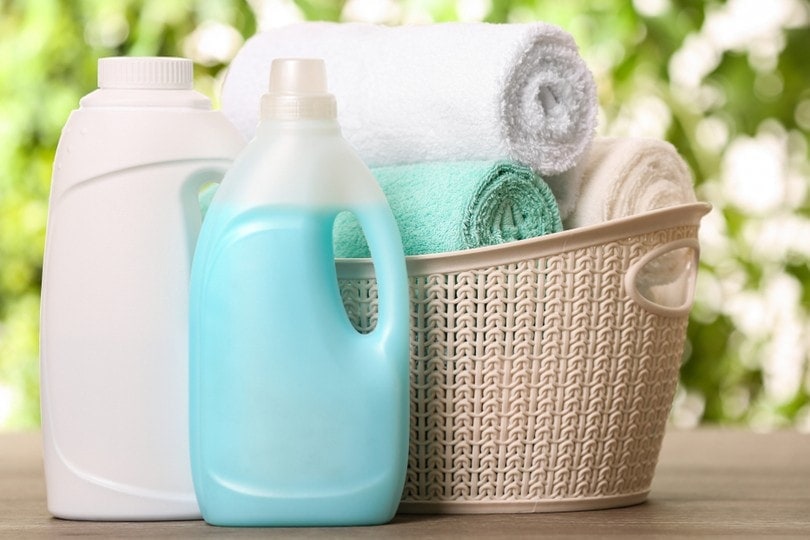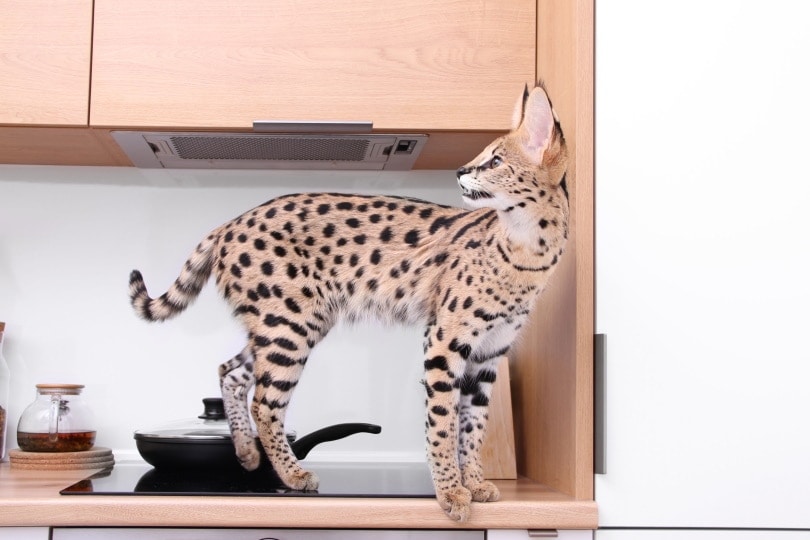How To Get Cat Urine Smell & Stains Out of Clothes: 4 Simple Steps

Updated on

A cat’s urine tends to be more concentrated than that of other pets. On top of that, when bacteria start to decompose the urea in the urine, it releases an upsetting ammonia-like smell.
Although the reason is unclear, different washing methods of cat urine have varying levels of effectiveness for different cat owners. Therefore, we’ve listed several methods that can help remove urine smell and stains from fabrics.
How to Get Cat Urine Smell Out of Fabric
When getting rid of urine stains and smells, the goal is to break down the composition of urea before bacteria can start to decompose it. The most effective way to remove urine from fabric is to pretreat and soak the soiled fabric and then run it through a wash cycle.
Make sure to follow these steps for the best chances of successfully removing cat urine smells and stains.
1. Pretreatment
One of the most effective things you can do is treat the fabric immediately after the incident occurs. This prevents the urine from deeply setting into the fibers and keeps bacteria from getting to the area. Take the fabric and rinse the stained spot under cool water. Resist the urge to scrub because this can push the urine deeper into the fabric.
Whatever you do, don’t skip pretreatment. If you put soiled clothes directly through a wash cycle, the urine will mix with the water to become further integrated with the fabrics. It’ll also spread to other garments, so you’ll end up with more clothes that smell like cat urine. Also, avoid using ammonia. Since the scent is similar to old cat urine, your cat may pee on the same fabric.
Another cleaning product to avoid is bleach. Cat urine mixed with bleach can cause a chemical reaction that releases toxic gasses.

2. At-Home Pretreatment Options
There are a couple of at-home remedies that you can try to remove cat urine stains and smells.
Baking Soda Mixture
First, you can try using baking soda and water. In a small bowl, pour out enough baking soda to cover the stained area on the fabric. Then, mix in a little bit of water incrementally until you create a paste.
Once you have a paste, scoop it out of the bowl and completely cover the stained area with it. Leave the paste on the stain for 15 to 20 minutes. After the time elapses, rinse off the paste and let the fabric air dry.
Salt Mixture
Another method is to use table salt, white vinegar, and borax powder. Mix equal parts of these three ingredients and use amounts that completely submerge the soiled clothes.
Once you’ve mixed these three ingredients, soak the clothes in the mixture and let it sit for 5 to 10 minutes. Once 10 minutes are up, rinse the clothes and let them air dry.
Vinegar Mixture
If you’re specifically trying to get rid of the urine smell, you can try using a white vinegar or hydrogen peroxide soak. Since white vinegar is an acid, it can damage some fabrics. So, make sure to spot-test vinegar before completely submerging the fabric in it. You can also dilute the vinegar by mixing one part water and one part vinegar.
As an acid, white vinegar will help break down alkaline salt found in cat urine that’s been sitting out for a while.
Hydrogen Peroxide
Soaking clothes in hydrogen peroxide can also help remove odors. If the strength of the hydrogen peroxide is at about 3%, it shouldn’t cause damage to your clothes. If you notice that the hydrogen peroxide is evaporating quickly, you can try covering it in plastic wrap to slow down evaporation.
Let the clothes soak for about 10-15 minutes. Then, rinse them and hang them to air dry before putting them through a laundry wash cycle.
3. Smell and Stain Remover Products
There are also cleaning products specifically developed to remove stains and odors. When you shop for spot cleaners make sure to find an enzyme-based cleaner. Enzymes will help break down urea to prevent odors from strengthening.
Soak the stained clothing in the enzyme-based cleaner for 10–15 minutes. Then, rinse off the cleaner and let the clothes air dry.
Our favorite enzyme cleaner is the Hepper Advanced Bio-Enzyme Pet Stain & Odor Eliminator Spray. It's our product, and we love it so much, we just have to share. It permanently removes the very worst smells and stains (yes, everything you can imagine!), and we offer a 100% satisfaction guarantee!
- ADVANCED ENZYMATIC CLEANER - Penetrates the most stubborn smells and stains at the deepest molecular...
- FOR ANY MESS, ON ANY SURFACE - This pet odor eliminator cleans your carpets, floors, furniture,...
4. Laundry Wash Cycle
There are several ways to wash pretreated clothes. First, you can use an enzyme-based detergent. You can add a pound of baking soda to the wash for additional reinforcement.
Another option you can try is washing the clothes with a cup of vinegar with no detergent. Then, run a second wash with an enzyme-based detergent. Once the wash cycle is up, air dry the clothes. Always air dry because the urine will set in the fabric if you use the dryer.
Reasons Your Cat Isn’t Using a Litter Box
It is important to understand why your cat isn’t using a litter box. Sometimes, it can be a health issue, such as a urinary tract infection. Work with your veterinarian to rule out any medical factors that may cause your cat to urinate anywhere.
Urinating outside of the litter box can also be due to a behavioral trigger. Cats that aren’t spayed or neutered have a higher tendency to urine marking. The litterbox may also be too dirty, so your cats may not want to step in it. If you have multiple cats, they may prefer using their own litter boxes. A lack of litter boxes may cause cats to relieve themselves elsewhere.
As a general rule of thumb, you should have one litter box per cat plus one extra litter box. So, if you have three cats, you should have at least four litter boxes throughout the house.
If you suspect that your cat isn’t using a litter box due to behavioral reasons, you can work with a cat behaviorist to pinpoint the cause and reason behind cats not using a litter box.
Sometimes even the best litter box setup needs a helping hand in combating invasive smells. Our Hepper Advanced Bio-Enzyme Cat Litter Deodorizer naturally breaks down odors at the source. This effective litter additive can help all types of cat litter last longer, saving you money, and is safe for all life stages. Best of all, it's 100% biodegradable and fragrance-free.
Final Thoughts
It takes multiple steps to remove cat urine from clothes and fabric and always make sure to do a pretreatment to break down the urine. Then, run the material through a wash cycle. You may have to do this a couple of times to completely eliminate the smell.
Once you remove the stain and odor, allow the fabric to air dry. After you’ve properly cleaned up stained material, make sure to spend time finding the reason why your cats aren’t using a litter box. This will save you a lot of time by eliminating the need to constantly wash soiled clothes and other fabrics.
Featured Image Credit: wilhei, Pixabay














